| Introduktion
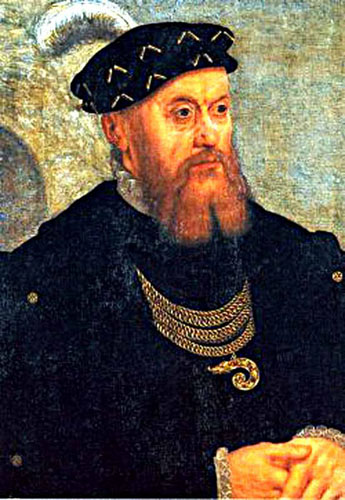
| | 1500-tallet var renæssancen og reformationens århundrede i Øresundsregionen.
Første tredjedel af seklet var præget af magtkampe mellem kongen, og de fire stænder. Kampene kulminerede i den såkaldte, grevens fejde, hvor kongen, Christian 3., og adelen fik styrket deres positioner
Vejen var hermed åbnet for reformationens definitive sejr i 1536, og kirken mistede hermed sin stærke økonomiske og politiske magt
I 1500-tallets sidste del skete der et enormt opsving i indenrigs og udenrigshandelen, hvilket medførte store indkomster via Øresundstolden.
Formuerne blev bl.a. anvendt til opførelse af kongens og adelens fornemme slotte og herregårde. |
Tiden omkring år 1500 betegner overgangen fra middelalder til renæssance. Renæssance betyder genfødsel (af italiensk: Re-nascio) og henviser til den omfattende genopdagelse, genanvendelse og videreudvikling af viden og teknik fra den klassiske tid, som tager sin begyndelse i Norditalien i 1300-tallet, og i løbet af 1500-tallet forplanter sig til det nordvestlige Europa.
Efterhånden kommer renæssancebegrebet også til at dække over en mere samlet, ny, eller om man vil, moderne virkeligheds- og menneskeopfattelse, med vægt på individets skaberevner og trang til at udforske omverdenen. Mennesket fremstår som individ og skaber virkeligheden i sit eget billede.
Tendensen iagttages tydeligt med portrætkunstens udvikling indenfor malerkunsten. Kongelige, adelige, borgerlige lader sig afbilde individuelt og også kunstneren fremstår efterhånden som navngiven person.
Kong Christian 2. (1513-23) fremstår som den tidstypiske regent og renæssancefyrste: På engang despotisk og fremsynet. Han ser byerne og borgerskabet som fremtiden, men formår ikke realisere sine visioner.
Inden for kirken styrkes reformkatolske strømninger under påvirkning af renæssancehumanismen. Malmø bliver litterært arnested for reformationen, som bl.a. starter med fordrivelse af franciskanermunkene inden 1536.
Kongemagten styrkes med inddragelsen af kirkens ejendom ved reformationen i 1536. Klassekampe imellem konge, adel og bønder, som kulminerer i forbindelse med Grevens Fejde 1534-36, gør tiden frem til omkring 1550 til en stilstandsperiode. Kongemagten forskanser sig med nye fæstningsagtige borgbyggerier, bl.a. Malmøhus.
Tiden omkring 1550 er præget af en europæiske højkonjunktur, der medfører øget handel og eksport i Østersøområdet og dermed også øget trafik igennem Øresund. Især råvarer - korn, kvæg, træ og mineraler - eksporteres til konsum og forarbejdning i Vesteuropa.
Den stigende handel og eksport betyder væsentligt øgede indtægter for den danske kongemagt via Øresundstolden og for adelen gennem eksport af landbrugsvarer. Disse indtægter danner udgangspunkt for kongelige og adelige byggerier i stor målestok og i det hele taget en pragtfuld levevis i renæssancens ånd.
Under Frederik 2..(1559-1588) samler kongemagten bl.a. ved at bytte jord med adelen store dele af sine besiddelser i Nordsjælland og opfører de fyrstelige byggerier Kronborg og Frederiksborg Slot i renæssancestil. Blandt adelige udvikles igennem dannelsesrejser sydpå øget interesse for renæssancens kultur og videnskab.
Tycho Brahe med hans forskningscenter Uranienborg på Hven er et lysende eksempel på renæssancens blomstrende interesse for videnskab og kultur. Adelige opbygger omfattende private biblioteker og renæssancens interesse for fortiden kommer bl.a. til udtryk i indsamling og nedskrivning af middelalderlige folkeviser. På dette område gør kvinder sig også gældende.
I starten af århundredet var der tre nordiske riger Danmark, Sverige og Norge knyttet sammen af Margrethe d.1.s Kalmarunion. Efterhånden løsgør Sverige sig af unionen, forholdet imellem Danmark og Sverige forværres gradvis og det udløser i 1563-70 Den nordiske Syvårskrig, den første af en række større, militære konfrontationer i og omkring Øresundsregionen.Konger og kunstnere
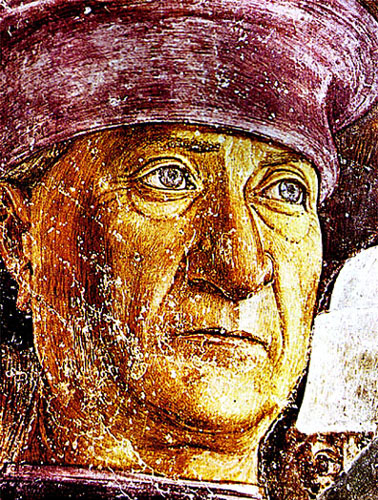
| | Et sikkert kendetegn på at renæssancens menneskeopfattelse er ved at bryde igennem er det individuelle præg der kommer i portrætkunsten.
Dette kommer i første omgang til udtryk i afbildningen af de kongelige, men breder sig siden hen også til adelige og borgerlige. |
Christian 1.
Et sikkert kendetegn på at renæssancens menneskeopfattelse er ved at bryde igennem er det individuelle præg der kommer i portrætkunsten. Det kommer i første omgang til udtryk i afbildningen af de kongelige, men breder sig siden hen også til adelige og borgerlige.
De første vellignende portrætter af danske regenter stammer fra Norditalien i slutningen af 1400-tallet, som f.eks. Mantegnas portræt af Christian 1. der befinder sig i fyrstepaladset i Mantova. I 1474 rejser kongen sydpå i et politisk-diplomatisk ærinde og familebesøg og kommer til renæssancens Italien, hvor han oplever en ny tids tendenser. På et kalkmaleri på slottet Malpaga ved Bergamo ses han afbildet til hest med langt skæg, på jagt med en tidstypisk skikkelse, den professionelle hærfører(condottiori), her den venetianske general Bartolomeo Colleoni.
På sin rejse møder kongen også paven, der et sted karakteriserer ham som "et smukt dyr, men desværre umælende", -kongen talte ikke latin, som fortsatte med at være de lærdes sprog ind i 1600-tallet.

Christian 1. | 
Christian 1. | 
Portræt af Christian 1. | 
Kongen og Paven |
Kong Hans og Adam van Düren
I 1479 opretter kong Christian 1., måske inspireret af sin rejse sydpå, Københavns Universitet. Kong Hans(1481-1513) fortsætter sin fars bestræbelser på at modernisere forholdene i riget og udsender i 1498 en forordning, hvorefter danske studenter først må lade sig indskrive på et udenlandsk universitet efter tre års studier ved Københavns universitet. Der findes intet malet portræt af Kong Hans, men et stiliseret relief på brøndkarmen i Lunds domkirkes krypt, tilskrevet Adam van Düren, antages at have portrætlighed.
Adam van Düren er et tidligt eksempel på en navngiven kunstner med alsidig kunnen og sans for iscenesættelse. En reliefbuste i en vinduesniche i Lunds domkirke antages at være et selvportræt af kunstneren.van Düren står bag en gennemgribende restaurering af Lunds domkirke i starten af 1500-tallet. Kong Hans går selv aktivt ind i projektet og giver retningslinier for at kirken bør føres tilbage til sit oprindelige udseende - måske et udslag af renæssancens tankegang om at genoplive og restaurere fortiden. Her drejer det sig i så fald om en interesse for den romanske fortid.

Kong Hans | 
Adam van Düren |
Skriften på brønden.
I forbindelse med restaureringen af domkirken i Lund etableres en brønd i krypten. Relieffet på brøndkarmens ene side forestiller, som allerede nævnt, kongen og en borgermand. Teksten på kongens skriftrulle Lyder: ”Æren Står over alle ting”. Modsat ses den måske første fremstilling af en byborger, en købmand, der holder fast om pungen og siger: ”Nej siger penningen, der hvor jeg vender mig hen er det slut med kærligheden”.
Samfundssatiren er også åbenbar på brøndens to andre sider. På det ene relief ses en borgerfrue og en munk med følgende tekst:” Mange giver en anden et godt råd , selvom han kun sjældent følger det”.På det tredje relief ses en kæmpelus der suger blod på et bundet får. Underteksten lyder: ”Den sultne lus bider fåret, det er vist. Gud hjælpe fåret, som er bundet og ikke kan klø sig. Derover må den sultne lus vel glædes”.
Man kan udlægge denne sætning som en henvisning til den stigende udbytning af bønderne og på sæt og vis rummer disse sentenser nærmest profetiske varsler om den kommende tids tumult og omvæltninger i forbindelse med reformationen og regulære borgerkrige.

Konge og borger | 
Munk og borgerfrue | 
Lusen og fåret |
Christian 2. – renæssancefyrsten
I Christian 2.s tid (1513-23)bliver tendensen til at kongemagten allierer sig med byborgerskabet tydelig og en væsentlig årsag til kongens fald i 1523. Borgerkongen Christian 2.s havde gennem giftermål og på anden vis stærke forbindelser til Nederlandene og det giver sig også udtryk i massiv kulturel påvirkning i renæssancens ånd.
Den velkendte og fremtrædende portrætmaler Michel Sittows portræt af kongen i nederlandsk 3/4-profil er måske det første portrætmaleri i moderne forstand i Danmark. Portrættet er et psykologisk studie af en magtfuld og mistænksom mand, eller måske blot renæssancefyrsten, som den italienske statsteoretiker Machiavelli skildrer ham i sit værk Fyrsten.
Christian 2. synes at have en vis evne til at lade sig portrættere af tidens førende kunstnere. Den tyske renæssancekunstner Albrecht Dürer har således også tegnet kongen i 1521. Portrætligheden i de to billeder er slående.

Christian 2. | 
Christian 2. |
Altertavlen fra Helsingør
Den nederlandske påvirkning er også tydelig i den oprindelige altertavle fra Skt. Marie Kirke i Helsingør, hvor kongen har ladet sig portrættere sammen med sin gemalinde i bunden af altertavlen, så man ikke kan være i tvivl om, hvem der har bekostet maleriet.
Hovedmotivet på tavlen er dommedag og de kongelige knæler i bunden i from bedestilling. Man kunne imidlertid også hæfte sig ved at kongen så at sige mænger sig med det gudelige i en anmasende selvfremstilling. På den anden side, hvis adelsmanden Poul Laxmand kan placere sine insignier over højaltret og en opkomling som sømanden Hans Pothorst lade sig afbilde i hvælvingerne i samme kirke, så kan kongen vel også lade sig afbilde på selve altertavlen.

Altertavle |
Borger Jørgen Kock
En af kongens trofaste allierede var Malmøs borgmester Jørgen Kock, ses på et meget tidligt borgerligt portræt. Kock var adelig, men foretrak åbenbart at lade sig protrætere som borgerlig. Måske en måde at demonstrere sin sympati for den adelsfjendtlige Christian 2. ?

Borgmester Jørgen Kock |
Bogtrykkerkunsten
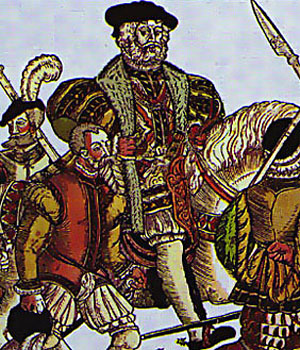
| | Bogtrykkerkunsten spiller en stor rolle i den politiske og religiøse kamp i første halvdel af 1500-tallet. Her flyveblad med Christian 2. til hest. |
Borgerkrig i landet
Borgerkongen Christian 2. rager uklar med adelen og fordrives i 1523. København og Malmø forbliver tro mod Christian, mens den skånske adel går over til den nye konge Frederik 1.Blandt bønderne, som udgjorde langt størstedelen af befolkningen, have uroen længe ulmet. Christian 2. havde forsøgt at lovgive imod at hindre bøndernes bevægelsesfrihed, dvs. imod køb og salg af bønder fra det ene gods til det andet.
"Bønder skulle icke hereffter selgis. Slig ond, uchristelig sæd som hertil i Sjælland, Falster, Laaland o Møen været haver med stakkels Bønder og christne Mennesker at sælge og bortgive ligesom andre uskjllige Kreatur ei skal her efter denne Dag saa ydermere ske (…)"
Ved kongens bortrejse kommer det til skattevægring og anden ulydighed på Sjælland og i Skåne regulært oprør, hvor man med Søren Nordby i spidsen hyldede Christian 2. I en proklamation til det danske folk fra eksil i 1525 kundgør Christian at både adelige og gejstlige herrer "ikke agtede en fattig bonde mere end en hund". Oprøret mislykkedes og de skånske bønder blev hårdt straffet for at have deltaget i oprøret mod Frederik I.
Propagandavåben
I det hele taget forstod Christian fra sit eksil at betjene sig af tidens nye propagandamidler, det trykte medium. F.eks. agiteres helt frem til 1530 i såkaldte flyveblade for kongens tilbagevenden.
Christian 2. mødte i 1523 Martin Luther personligt og gik over til den nye, reformerte kirkelære. Allerede samme år foranlediger han fra sit eksil, bl.a. med deltagelse af den tidligere Malmö-borgmester og købmand Hans Mikkelsen, en første dansk oversættelse og trykning af Det nye Testamente.

Det ny Testamente på dansk | 
Christian 2. |
Humanisten Christiern Pedersen
I 1529 udkommer endnu en, sproglig set væsentlig forbedret udgave af Det ny Testamente, som to år senere genoptrykkes. Hovedmanden bag denne udgave var Christiern Pedersen, tidligere kannik i Lund. Han deltog i det skånske oprør til fordel for Christian 2., går over til den ny lære og slutter sig til den landflygtige konge i 1526. Christiern Pedersen var født og opvokset i Helsingør og blev en af tidens fremtrædende humanister I en årrække levede han i Paris, hvor han i 1514 stod bag den første trykte udgave af Saxos danmarkshistorie, Gesta Danorum, fra 1200-tallet - et udslag af tidens interesse for genoplivningen af fortidens historie.
Efter sin tilbagevenden til Danmark i 1532 får Christiern Pedersen lov til at nedsætte sig i Malmø, hvor reformationen praktisk taget allerede er gennemført i 1529, og arbejder her særdeles aktivt for sagen. Bl.a. udgiver han i i 1531 et skrift Om Børn at holde til Skole og Studium, som agiterer for en ny og mere human pædagogik. Det er også hans oversættelsesarbejde der ligger til grund for den første samlede danske bibeloversættelse, som udgives i 1550 og kendes under navnet Christian 3.s Danske Bibel.

Saxos Danmarkshistorie | 
C. Pedersens lægebog | 
Christian III´s Bibel | 
Latinskolen i Ystad |
Reformationen
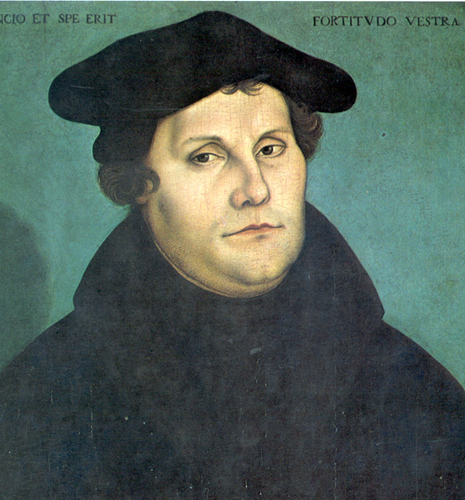
| | Martin Luther (1483-1546) tysk teologiprofessor og reformator, var en af flere som protesterede mod det forfald, som mange anså gennemsyrede den katolske kirke.
Det var Luthers forslag om at reformere kirken, der lå bag reformationen i Danmark, hvor reformatorer i Danmarks store byer: Viborg, Haderslev, København og frem for alt, Malmø, førte an i overgangen til den reformerte, lutherske trosretning. |
Reformationsbølgen i Europa
I senmiddelalderen gik der en bølge af reformationsbestræbelser gennem det kristne Europa. Den tyske teologiprofessor Martin Luther (1483-1546) var blot en af flere, som protesterede mod det forfald, som mange anså gennemsyrede den katolske kirke. Luther angreb især pavemagten, afladshandelen og gerningslæren, det vil sige, at mennesket kunne frelse sig selv, ved sine gode gerninger. I stedet propaganderede han for en kirke, som havde Bibelen som højeste autoritet, og hvor troen skulle være det grundlag, som frelsen byggede på.
Luther fandt, at der var alt for meget i den katolske religionsudøvelse, som der ikke var belæg for i Bibelen: Helgendyrkelsen, Mariakulten, klosterlivet og præsternes cølibattvang var blandt de eksempler, som skulle fjernes fra kirkens lære. Han betragtede kongemagten som en langt bedre garant for en seriøs kirke end pavemagten. Det kan derfor ikke undre, at flere af fyrsterne i Europa følte sig voldsomt tiltrukket af den lutherske lære.

Martin Luther | 
Afladsbrev |
Magtkamp i Danmark - Grevens fejde
Danmarks konge efter Christian 2.s afsættelse 1523, Frederik I., havde givet den fremvoksende lutherdom en vis forsigtig støtte, selvom han i sin strenge håndfæstning havde lovet de katolske biskopper at bekæmpe al "kætteri". Efter Frederik I.s død i 1533 nægtede biskopperne at anerkende hans søn, Christian som konge. Bl.a. fordi han åbent var gået over til lutherdommen og havde indført den i de områder i Slesvig, hans fader havde forlenet ham.
Malmøs og Københavns borgere ønskede at genindsætte Christian 2., men det fandt biskopperne uinteressant, eftersom han, som sin fætter Christian, også var en stor tilhænger af Luthers lære.
Modsætninger mellem adel og borgerskab førte til en voldsom borgerkrig, den såkaldte Grevens fejde, hvor landets borgerskab og den jyske almue satte grev Christoffer af Oldenburg (heraf navnet)til at lede en lübecks hær mod den danske adel. I denne situation støttede Sverige den jyske adels foretrukne tronfølger Frederiks søn, Christian. Og i 1534 blev Christian Danmarks konge under navnet Christian 3. I forening med den yderst professionelle feltherre,Johan Rantzau,fik kongen besejret hæren fra Lübeck og nedslagtet den jyske almues bondehær, der var under ledelse af Skipper Clement.

Frederik 1. | 
Christian 3. Reformationskongen | 
Johan Rantzau | 
Malmøhus |
Reformationen gennemføres
Magtovertagelsen betød, dels at adelen fik stor indflydelse, dels at der nu var opstået mulighed for at gennemføre reformationen. Men først skulle de katolske biskopper fjernes. Ved Rigsdagen i København fik biskopperne skylden for de kaotiske tilstande, der nu rådede og for deres direkte modstand mod at få en lutheraner på tronen.
Resultatet blev, at alle biskopperne blev afskediget, deres jordejendom blev konfiskeret og deres indtægter, via bispetiendet, overgik til staten. Året efter blev den katolske kirkes skæbne beseglet: Der blev vedtaget en ny kirkeordning, som var i nøje samklang med den lutherske lære, og i 1536 var reformationen i Danmark gennemført.
Vejen til Reformationen havde været lang og møjsommelig og reformationens idéer havde forlængst slået rødder såvel i Danmark som i mange af de omgivende lande.

Kirkeordinansen |
Kirkelig selvkritik
Selv indenfor den katolske kirke i Danmark var der i begyndelsen af 1500-tallet kritik af de misforhold og den grådighed, der rådede i pavens kirkedømme. Man ønskede reformer og en ledende skikkelse indenfor denne reformkatolicisme var den danske karmelitermunk og universitetslærer, Poul Helgesen. Helgesen var især skeptisk over for katalocismens omfattende religiøse svindel og bedrageri med begrebet, afladshandel. Han forblev dog tro overfor den katolske kirke.
Tidlige prædikanter
Der forekom langt mere radikale og tidligere kritikere af den katolske kirke end Poul Helgesen. Et tidligt centrum for lutherdommens udbredelse i Danmark blev eksempelvis Haderslev i Sønderjylland. Allerede omkring 1525 blev der i byen åbnet en præsteskole, hvor luherdommen var grundlaget for de nye præsters virke.
En af de mest kendte og markante kritikere af den katolske kirke var også tidligt på færde. Det var johanittermunken Hans Tavsen, som blev den første præst, der fuldt ud gennemførte lutherdommen i sin prædiken og virke. Først i Viborg, Jylland og senere i København.
En af de mest gennemslagskraftige manifestationer for den nye lutherske lære var Herredagen i Odense i 1527. Her blev det fastslået, at troen var en frivillig sag, og at en evangelisk frikirke var tilladt.

Hans Tavsen, den danske Luther |
Malmøs reformatorer
Malmø blev et tidligt centrum for lutherdommen, hvor præsten Claus Mortensen blev den ledende skikkelse. Han havde prædiket Luthers lære i København, da han i 1527 blev opfordret til at vende tilbage til sin fødeby Malmø af borgmesteren og møntmesteren Jørgen Kock. Mortensen begyndte med at prædike i et lille kapel udenfor Malmø, men drog så store tilhørerskarer, at han med tiden flyttede sin prædikantvirksomhed til Petri Kyrka i byens centrale del.
En tidligere munk, Hans Spandemager sluttede sig til reformationstanken og Mortensen og Spandemager udarbejdede den første evangeliske messe på dansk. Denne messe fik navnet "Malmømessen".
Ærkebiskoppen i Lund, Aage Jepsen Sparre, reagerede stærkt mod begge reformatorerne, og det lykkedes ham at få dem forvist fra Malmø. I 1528 flyttede de da til Haderslev.
Efter en tid i Haderslev vendte Claus Mortensen og Hans Spandager i sommeren 1529 tilbage til Malmø. Men nu havde de et beskyttelsesbrev med fra Kong Frederik I. Dermed var de fredede og reformationsarbejdet kunne intensiveres. Tre tidligere karmeliterbrødre, Frans Vormordsen, Peder Laurentsen og Anders Ljung deltog nu i reformationskampen og blev desuden ledende personer i den lutherske præsteskole, som startede i Malmø. (De var alle tre tidligere elever af reformkatoliken Poul Helgesen)

Borgmester Jørgen Kock | 
Kockska hus | 
C.Mortensens gravsten |
Malmø- en luthersk by 1529
Malmøs borgere blev efterhånden stærkt anti-katolske, og den katolske sognepræst så sig tvunget til at afgå fra sin stilling i slutningen af september 1529. Claus Mortensen blev herefter indsat som ny sognepræst i byen. En af hans første kirkelige handlinger var at gennemføre en billedstorm i Sct.Petri Kirke. Billeder og statuer, som man ikke mente stemte overens med den "rene" lutherske lære, blev smidt ud på gaden og ødelagt.
Fra nu af var Malmø at betragte som en luthersk stad. Det vil sige to år efter Sveriges overgang til lutherdommen og hele syv år før reformationens endelige sejr i resten af Danmark. Den første lutherske præstevielse i Danmark gennemførtes i Sct.Petri Kirke i Malmø i 1531

Petri Kirke i Malmø | 
Series pastorum |
Malmøbogen og Krøniken - to kilder om reformationen
Peder Laurentsen skrev i 1529 den såkaldte "Malmøbog", som gav en luthersk forklaring på reformationen i Danmark. Titlen på værket var ”Årsagen og en ret Forklaring på den ny Reformats”. Skriftet regnes for et af den tidlige reformations mest betydningsfulde værker. Af den oprindelige udgave eksisterer der endnu et enkelt eksemplar, som findes på universitetsbiblioteket i Lund.
Den katolske kirkes syn på hændelsesforløbet findes beskrevet i ”Cronica seu brevis processus in causa expulsionis fratrum minoritarum de suis cenobiis provincie Dacie”, oftest kaldet "Krönikan over gråbrödernas fördrivning" från 1534.
Tiggermunkene
Tiggermunkene var den etablerede kirkes avantgarde. Nogle klosterordener var direkte knyttet til pavestolen, og de aflukkede klostersamfund var ikke ligeså integrerede i det omgivende samfund som f.eks. sognekirkerne. De var kort sagt mere udsatte, og det var også i høj grad dem og især tiggermunkene, der kom
til at stå for skud i slutningen af 1520erne.
Allerede i 1527 er der klager over, at de fattige munke ikke kan gå i fred og kongen, Frederik 1.udsteder i første omgang et brev til lensmændene om at beskytte dem. Senere, da kongen ser sin fordel i at overtage kirkens ejendom, deltager han nærmest aktivt i fordrivelsen af tiggermunkene.
Angreb mod klosteret i Malmø
I Malmø blev der nu, under Claus Mortensen, indledt skarpe angreb på klostrenes virksomhed. I begyndelsen var der tale om verbale angreb fra prædikestolene, men efter at Mortensen var blevet sognepræst i Malmø, så overgik man til korporlig forfølgelse af munkene, de blev, helt enkelt, drevet ud af deres klostre med vold.
Reformatorerne havde bred opbakning fra Malmøs borgere. I byen fandtes der to klostre. Dels Helligåndsklosteret, ved det nuværende Stortorget, dels franciskanerklosteret, gråbrødrenes kloster.
Under høsten i 1529 blev helligåndsbrødrene drevet bort fra deres kloster og i maj 1530 blev franciskanerne drevet bort. Dette skete under ret så dramatiske former. Gråbrødrene blev f.eks. låst inde i spisesalen og herefter bedt om at fjerne sig fra klosteret.
Angreb mod klosteret i Ystad
I 1532 blev det Ystads gråbrødre, der skulle fordrives. Med et kongeligt brev krævede borgmesteren at munkene blev fordrevet. Da forhandlingerne om dette brød sammen, gik byens borgerskab til angreb. De internerede klosterets ledere, forbød brødrene at udføre kirkelige handlinger, og til sidst drev de brødrene bort.
Tiggermunkenes skæbne blev beseglet gennem et foreskrift i 1537:
”Ingen tiggermunke må efter denne dag opholde sig i vore riger; hverken skal de tigge eller prædike eller høre skriftemål. Men de, som er gamle og skrøbelige og ikke duer til noget kirkeligt embede, de må blive i klostret, og der må de have deres føde for Guds skyld. Dog skal de aflægge kappen og klosterklæderne og ikke bespotte Evangeliet”.
Ærkebiskopstitlen afskaffes
Ærkebispesædet i Lund blev besat af Frands Vormordsen fra Malmø. Han blev viet til superintendent den 2. september 1537. Superintendenden blev den nye titel på biskoppen i Lund. Reformationens gennemførelse var dermed endelig afsluttet.
Forkyndelsen i centrum
Med udgangspunkt i den lutherske lære blev der nu rettet en lang større opmærksomhed på fortolkningen af bibelens tekster, altså selve forkyndelsen. Præstens prædiken var ikke ukendt i den katolske kirke, men i den lutherske kirke blev prædikenen gudstjenestens absolutte hovednummer. Man kan sige, at fokus i gudstjenesterummet blev flyttet fra alteret til prædikestolen.
Et synligt tegn på dette i kirkerummet var, at der nu blev installeret nye og kostbare prædikestole. Der findes således en række pragteksemplarer af disse der, den dag i dag, kan beses i Øresundsregionens kirker fra 15- og 1600-tallet.

Forkyndelsen | 
Lunds prædikestol | 
Petri prædikestol | 
Sct. Maria prædikestol i Helsingborg |
Økonomisk vækst
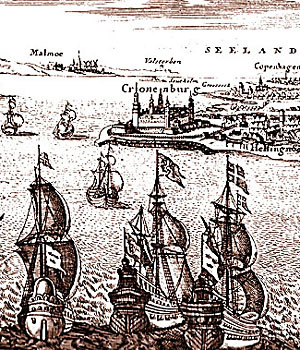
| | Handel og sejlads i Øresundsregionen blev øgest betydeligt i tiden fra omkring år 1550, hvor der var ca. 3000 årlige passager, til et godt stykke over 5000 i 1590erne.
Baggrunden var en generel højkonjunktur i europæisk økonomi og betydelig økonomisk vækst i Øresunds- og Østersøregionen, hvorfra man eksporterede landbrugsprodukter og råvarer som træ, jern og kobber; primært til vækstcenteret omkring Den engelske Kanal. |
Højkonjunktur
En økonomiske højkonjunktur præger det samlede Europa i 1500-tallet og frem til omkring midten af 1600-tallet. Den begyndende vareproduktion i Norditalien og i andre bysamfund rundt omkring i Europa, øget handel med både råstoffer og færdigvarer og i forbindelse med Opdagelsestiden øget tilgang af ædelmetaller virker i høj grad stimulerende på den økonomiske udvikling.
I løbet af 1500-tallet flyttes det økonomiske tyngdepunkt til nordvestlige Europa, kanalområdet med Flandern og England, som efterhånden også bliver centrum for handelen på Amerika. Væksten i kanalområdet kræver øgede tilførsler af råvarer og fødevarer og hermed kommer Østersøområdet og sejladsen gennem Øresund til at spille en stigende rolle.
Udviklingen i Øresundsregionen
I Danmark sætter udviklingen sig for alvor spor i tiden under Christian 3.(1534-59). Kongemagten er blevet styrket gennem overtagelse af kirkens jordejendomme og sammensmeltning af kirke- og kongemagt. Forholdet til adelen afbalanceres gennem nye lensforordninger, hvorved adelen også får øget andel i den voksende rigdom. De gunstige konjunkturer får også afsmittende virkning på bysamfundene i området. Udviklingen indenfor håndværk og handel konsolideres og der sker en massiv indvandring, specielt til Helsingør, der ude omkring i verden kaldes "Lille Amsterdam".
Korn- og især studeeksporten vokser bestandigt og fra midten af 1500-tallet stiger priserne hastigt på netop disse produkter. Kornpriserne fordobles fra 1520erne frem til omkring 1560 og mere end fordobles igen ind i 1590erne. Sejladsen igennem Øresund stiger også gevaldigt fra ca. 3000 fartøjer omkring år 1550 til et godt stykke over 5000 årlige passager i 1590erne. Hermed stiger kongemagtens indtægt fra Øresundsstolden betydeligt, ligesom den også øges yderligere igennem en omlægning af tolden i 1567. Fra 1566-67 steg afgiftsprovenuet således fra 45.000 til 132.000 daler.

Øresund | 
Søkort 1585 | 
Skånekysten 1585 | 
Nordsjælland 1585 | 
Toldboden, Helsingør |
Adelsvælde
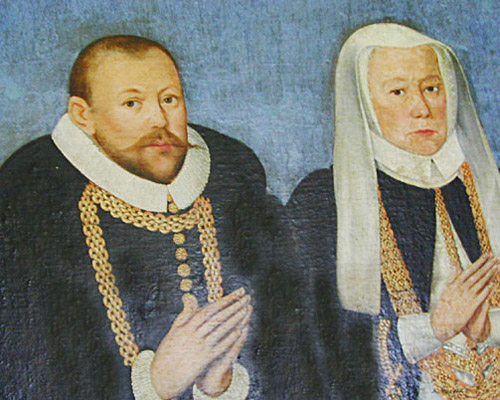
| | Det samfund der tegner sig omkring midten af 1500-tallet er stærkt klassedelt.
Højadelen skiller sig ud som en snæver overklasse bestående af 2-300 familier med umådelig rigdom og indflydelse og på den anden side en voksende underklasse i bunden af samfundet, som er overladt til almisser. |
Det samfund der tegner sig omkring midten af 1500-tallet er stærkt klassedelt. Højadelen skiller sig ud som en snæver overklasse bestående af 2-300 familier med umådelig rigdom og indflydelse og på den anden side en voksende underklasse i bunden af samfundet, som er overladt til almisser. Det gør det ikke nemmere at en række sociale og sundhedsmæssige opgaver, som den katolske kirke og klostrene varetog kun langsomt overtages af nye institutioner, som eksempelvis de nye helligåndshuse i de større byer, eller helt overlades til privat godgørenhed og næstekærlighed.
Næstekærligheden
En altertavle ophængt i Mariakyrkan i Helsingborg i 1583 tematiserer dette. Tavlen rummer et dobbeltportræt med en undertekst og tre mindre billeder over hinanden i venstre side at tavlen. Portrættet viser et adeligt ægtepar, måske er det, genkendeligt på de gyldne kæder der symboliserer den adelige rigdom og magt, lensmanden på Helsingborg slot Arild Urup og hans hustru Thale Thott. Underteksten lyder:
"I kristne som Gud har givet nok betænk de fattige, som lider sorg, sygdom, jammer og nød, armod, fattigdom og hunger efter brød, noget i denne blokbøsse. Bevis eders tro med skønne gerninger og Gud i himmerige vil eder det velbehageligt."
Motivet nederst i venstre hjørne er, ligesom i spisesalen i Sct. Marie Kirke i Helsingør, Lazarus-fortællingen, med helvede og himmel ovenover. Forestillingen om at de gode gerninger stemmer Gud velbehageligt synes således at overleve reformationen.

Adeligt par |
Donationer
Privat godgørenhed begrænser sig imidlertid ikke til almisser til de fattige, men f.eks. også oprettelse af legater og understøttelse af skoler. Et godt eksempel herpå er ægteparret Herluf Trolle og Birgitte Gøye.
Et portræt af Birgitte Gøye fra 1550 viser en person behængt med gyldne kæder, symbolet på den adelige værdighed. Birgitte Gøye var datter af rigshovmester Mogens Gøye og tilhørte den snævre skare af højadelige familier, hvor giftermål var ensbetydende med jord-politik. Birgitte Gøye nægtede imidlertid at gifte sig med den slægten har udset sig til hende og må vente 15 år, frem til 1540, på at få sin elskede, den senere rigsadmiral Herluf Trolle.
Herluf Trolle er født på Lillø i Skåne, som nummer 12 i en børneflok på 15, så hans personlige ejendom var trods alt begrænset. I ægteskabet med Birgitte Gøye gifter han sig til store besiddelser, bl.a. Hillerødsholm og Græsede i Nordsjælland, som ægteparret bytter med kongen for Skovkloster ved Slagelse. Dette bliver senere udgangspunkt for Herlufsholm kostskole for adelige, mens Hillerødsholm tillægges Frederiksborg Slot. Herluf Trolle er berømt for den selvkarakteristik af en adelig, som han kort før sin død i 1565 giver historikeren Niels Hemmingsen.

Birgitte Gjøe (1551-1574) | 
Herluf Trolle |
Kunstmæcener
Birgitte Gøye var også en af tidens store kunstsamlere, bl.a. importerer hun formodentlig fra Antwerpen 3 tavler i renæssancestil, men nogle af de ting der erhverves kan også være købt af forbipasserende skibe. En såkaldt legattavle i renæssancestil fra 1568 hænger i Helsingørs Skt.Olai Kirke.Tavlen refererer til den medfølgende pengegave.
Birgitte Gøye og Herluf Trolle, der forblev barnløse, skænker legater til latinskolen i Helsingør, Roskilde og Næstved og opretter som allerede nævnt Herlufsholm kostskole for adelige.

Legattavle |
Nærmere Gud til dig ...
Trangen til at lade sig portrættere og forevige i Guds nærhed griber med tiden efter reformationen både adelige og borgerlige. Endnu et eksempel på den adelige portrætkunst stammer således fra kirken ved Bosjökloster i Skåne, som kongen i 1560 byttede med Laxmand-familien for besiddelser på Sjælland, Stenholt ved Hillerød, efter at familien i øvrigt havde fået sine konfiskerede ejendomme tilbage igen.
Kirken var en såkaldt patronatskirke, hvor den lokale herremand udnævnte præsten og på anden vis satte sit præg på kirken. I Bosjökloster i Skåne udvikler det sig til det rene portrætgalleri. Familieportrættet er anseeligt af størrelse og viser bl.a. den stormægtige enke Thale Ulfstand knælende med pårørende, den afdøde mand, Poul Laxmand(den yngre), 2 sønner og datteren Birthe med hendes to mænd, i en næsten legemsstor gengivelse. Thale Ulfstand boede 44 år på stedet som enke.
Med tiden udvikles et bestemt genremaleri, et epitafium, eller en mindetavle over familierne, til brug for ophængning i kirkerne. Disse epitafier kommer næsten til at erstatte den katolske tids udsmykninger, men her er det vel at mærke i renæssancens ånd autentiske individer der afbildes.

Laxmand familien | 
Laxmand familien (udsnit) | 
Thale Ulfstand | 
Ung mand |
Slotte og herregårde

| | Stigende indtægter fra landbrugseksporten forgylder adelen, som fra omkring 1550 investerer en del af midlerne i prestigefyldte byggerier i tidens smag.
Vitskövle Slot i det nordøstlige Skåne, opført i 1550erne af Brahefamilen, er et tidligt eksempel herpå. |
Adelsbyggeri
Kongemagten og højadelen enorme indtægtsstigninger i perioden investeres i vidt omfang i prestigefyldte renæssancebyggerier i tidens smag. Fra anden halvdel af 1500-tallet og ind i 1600-tallet påbegynder adelen et byggeri af hovedgårde der den dag i dag sætter sit præg på det skånske landskab. Omkring 150 af disse byggerier står stadigvæk tilbage, mens ca. 20 er forsvundet. Antallet af intakte renæssanceherresæder er dog stærkt reduceret af 1800-tallets romantiske restaurationsdille.

Adelens byggeri |
Vittskövle, Skarhult, Torup
Et tidligt og meget velbevaret eksempel er Vittskövle Slot i det nordøstlige Skåne, der er Skånes største borgbygning opført af Brahefamilien i 1550erne og omgivet af brede voldgrave.
Vittskövle Slot har endnu noget af middelalderborgens massive tyngde. I tilknytning til slottes findes et kapel for Brahefamilien. Her ses et billede i stil med Bosjöklosters familieportræt. Tilsyneladende er det et modefænomen, der breder sig.
Beate Huitfeldts Skarhult i Midtskåne er et massivt og velbevaret byggeri, som med de svungne gavle henviser til renæssancen i en særegen byggestil.
Torup i nærheden af Malmø rummer ligesom Vittskövle træk af borgbyggeri. Den oprindelige middelalderborg blev ødelagt under Grevens Fejde og i perioden 1537-1550 opførtes denne tidlige renæssanceborg.

Vitskövle | 
Brahe familien | 
Adelsfamilie | 
Skarhult | 
Torup |
Svenstorp og Rosendal
Herresædet Svenstorp i Lunds kommune fra 1592 er opført i den såkaldte Christian 4.stil i røde teglsten vekslende med hvide sandstenbånd og vinduesindramninger. Svenstorp er åbenlyst ikke en fæstning, nærmere et prangende lystslot. Indgangsportalen tilskrives Hans van Steenwinkel, der også arbejder på Kronborg.
Renæssanceherresædet Rosendal, som ligger tær på Söderåsen, er opført at Anders Bille i 1615-17 og står næsten fuldstændigt bevaret den dag i dag. Rosendal er også et åbent slotsanlæg, dog omgivet af vand på flere sider. Over den ene indgangsport findes alene Anders Billes navnetræk og våbenskjold, da han giftede sig under sin stand.

Svendstorp | 
Rosendal Slot | 
Anders Bille | 
Billehuset |
Sjællandske herregårde
På Midt- og Sydsjælland, der ligesom Skåne tilhørte adelen, findes også en lang række herregårde i renæssancestil. Gisselfeld hører også til de tidlige herreborge der opførtes i tiden efter Grevens Fejde. 1547 står der at læse på hovedbygningen, påbegyndt af Per Oxe og fuldendt før hans død i 1575.
Vallø i nærheden af Køge har visse ligheder med Skarhult i Skåne: Bastant med de to høje tårne i fem etager. På det oprindelige byggeri fra 1580-86 var sydfløjen med de to tårne kun i to etager, men forhøjes så omkring 1610.
Lystrup nær Fakse et tidligt eksempel på nederlandsk renæssance, hvor der ligesom på Svenstorp i Skåne anvendes røde teglsten i kombination med hvide sandsten. Det er så indlysende et mindre lystslot, opført for Eiler Grubbe i 1579. De mange sandstensarbejder kan være udført af Hans Steenwinkel den ældre, der også arbejdede på Kronborg.

Gisselfeld Slot | 
Gavnø | 
Lystrup Slot |
Den nordiske syvårskrig 1563-70

| | Omkring 1560 er to unge stridslystne konger, Frederik 2.og Erik 14., kommet på tronen og det trækker op til direkte konfrontationer, som udløses med Den Nordiske Syvårskrig Krig fra 1563-70.
De konkrete årsager til krigsudbruddet var mangfoldige og banale, men det grundlæggende forhold var at Sverige efterhånden følte sig omklamret og indespærret af det dansk-norske kongerige. |
Unionens ophør
De nordiske samlingsbestræbelser der, med vekslende held, pågår under dronning Margrethes Kalmarunion fra 1397 rinder endeligt ud i begyndelsen af 1500-tallet, hvor der også går en bølge af national vækkelse over både Danmark og Sverige.
Det første tiår af 1500-tallet er en lang konfrontation imellem de to parter og med Christian 2.og Det Stockholmske Blodbad i 1520 sættes punktum for unionsbestræbelserne.
I tiden herefter etablerer Sverige sig for alvor som nationalstat, der opstår et skærpet modsætningsforhold, men Brömsebropagten fra 1541 forhindrer indtil videre direkte konfrontationer.
Stridslystne konger
Omkring 1560 er to unge stridslystne konger, Frederik 2.og Erik 14. , kommet på tronen og det trækker op til direkte konfrontationer, som udløses med Den Nordiske Syvårskrig Krig fra 1563-70. De konkrete årsagerne til krigsudbruddet var mangfoldige og banale, men det grundlæggende forhold var at Sverige efterhånden følte sig omklamret og indespærret af det dansk-norske kongerige.
Det havde længe generet at eksport sydover fra Småland skulle igennem danske besiddelser og mod vest havde Sverige kun en udsat støttepunkt ved Götaelvens munding, Älvsborg.

Kort fra 1570. | 
Sverige følte sig indespærret. | 
Belejringen af Elfsborg 1563. |
Civil terror
I 1563 udbryder der krig. Älvsborg blev erobret af danskerne i september 1563 og måtte i sidste ende købes tilbage af svenskerne. Der kæmpes indædt både til vands og til lands og ved krigens afslutning er begge riger dybt forarmede, bl.a. af enorme udgifter til de for tiden typiske lejesoldater, som betragtede plyndring og hærgen som en del af deres betaling. Strategien var så vidt muligt at undgå direkte konfrontationer og militære tab og i stedet at lade civilbefolkningen holde for.
Værst gik det udover civilbefolkningen i Skånelandene og Sydsverige, -begge parter i krigen anvendte terror mod civilbefolkningen i et hidtil uset omfang. Rönneby i Blekinge bliver angrebet d. 4. september 1564 af svenskerne og kong Erik beretter selv lidt senere herom:
”Rødt som blod farvedes vandet af de døde kroppe. Fjenderne var så forskræmte, at man ikke havde megen umag med dem, men stak dem ned som en flok svin, så at i staden blev mere end to tusinde mand uden halsen, foruden kvinder og børn, som finnerne slog ihjel.”
Blokadevåben
Danmark anvender i 1565 en blokade af Øresund som våben i krigen og skaber sig herved farlige fjender. Sverige var selvforsynende med fødevarer, men især Holland var dybt afhængig af kornforsyninger fra de baltiske lande og rammes hårdt. Der udbryder hungersnød i landet og både Holland og Spanien overvejer at erklære Danmark krig.
Hertil kommer at Øresundstolden i 1567 omlægges og hæves betydeligt. Indtægten heraf stiger på et år fra 45.000 rigsdaler i 1566 til 132.000 det efterfølgende år, men Frederik 2.s. 3000 lejesoldater kostede alene 150.000 daler, - om måneden!
Den 13.december 1570 underskrives en fred i Stettin, som forsøger at tage højde for mægling i fremtidige konflikter. De danske og svenske rigsråder forhindrer i et godt stykke tid fremover yderligere konfrontationer, men i det efterfølgende århundrede bliver Øresundsregionen gentagne gange hærget af krigshandlinger.

Kampen om Østersøen | 
Svenske skibe i Øresund |
Kronborg
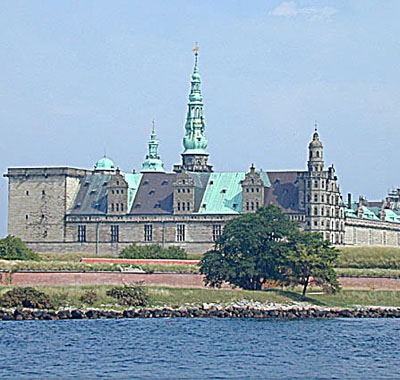
| | Kronborgs bygmestre er to hollandske arkitekter og stilen er nederlandsk renæssance.
Byggeriet påbegyndes i 1574 under Hans van Paeschen, indvies i 1582 og står færdigt i 1583. I den anden bygningsfase under Antonius von Opbergen beklædes slottet med skånsk sandsten fra et brud ved Helsingborg. |
Opførelsen af Kronborg
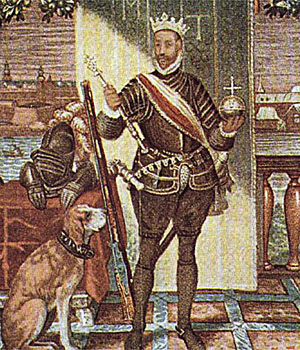
| | Efter reformationen i 1536 overtager kongemagten kirkens vidtstrakte jordegods i Nordsjælland.
Ved at bytte ejendomme med adelen samles store dele af kongemagtens jordejendom i Nordsjælland og under Frederik 2.(1559-1588) begynder opførelsen af fyrsteboliger i renæssancestil. |
Skåne bliver i løbet af 1500-tallet overvejende adelens domæne, mens kongemagten samler store dele af sine besiddelser i Nordsjælland. Kongen bytter jord med en række adelsfamilier og i Frederik 2.s regeringstid(1559-88) påbegyndes et storstilet nybyggeri med Frederiksborg og Kronborg Slot.
Øresundstolden omlægges
Ved Helsingør lå endnu ved midten af 1500-tallet kongens middelalderborg Krogen og gennem indtægterne fra Øresundstolden havde kongemagten også tæt tilknytning til byen. I 1567 beslutter Frederik 2., på foranledning af lensmanden Peder Oxe, at omlægge Øresundstolden således at der fremover ikke betales pr. skib, men efter ladningens værdi. Det medfører en betydelig forøgelse af indtægterne fra 45.000 daler i 1566 til 132.500 daler i det efterfølgende år og stigende til omkring 200.000 daler årligt i 1620´erne.

Krogen 1420 |
Det nye Slot
I begyndelsen af 1570erne opstår så tanken om at opføre er mere tidssvarende anlæg på dette strategisk vigtige sted. Projektet påbegyndes i 1574 i en første fase frem til 1577. Dette år foretages en revision af byens privilegier, der tilsiger frihed fra skat "og anden besværing" i 20 år.
Kongen understreger i privilegiebrevet at tilflytterne skal nyde de samme friheder og privilegier som de fastboende, men også undergive sig borgmester, rådmænd og stadsretten. Formodentlig har kongen brug for at skabe bedre vilkår for de mange tilrejsende håndværkere og tillige vinde borgernes velvillighed omkring det store projekt ved Kronborg. Endnu et vidnesbyrd om kongens imødekommenhed overfor byen kommer måneden efter:
"...Eftersom borgermestre og råd i Helsingør haver givet tilkende, at det marked, der holder der ved Sct. Mikkels dag, er byen mere til skade og besværing end gavn, nytte og forfremmelse, så skal dette marked aldeles aflægges, på det at borgerne i Helsingør ikke skal have hinder og skade deraf på deres handel, næring og bjergning..."
Bygherren Frederik II
Opførelsen af Kronborg og det liv der udfoldede sig her omkring viser Frederik 2. som den virkelystne og alsidigt interesserede renæssancefyrste. Kongen følger med nidkær interesse byggeriets udvikling, blander sig ned til mindste detalje, og har afgørende indflydelse på byggeriets endelige udformning.
Der eksisterer bl.a. i Øresundtoldens regnskaber et righoldigt materiale til at belyse forskellige faser og enkeltheder i forbindelse med slottets opførelse og påfølgende ombygninger og indretning. Ud fra regnskaberne kan den samlede pris for byggeriet anslås til 430.000 daler.
To byggefaser
Kronborg blev ikke bygget efter en på forhånd fastlagt plan, men udviklede sig over Krogens grundplan. Erik af Pommerns Krogen var en middelalderfæstning, kvadratisk i sin grundform, 80 meter på alle leder og med et hus i hvert hjørne, bygget ind i ringmuren og med udgang mod nord. Det er over denne grundplan at Frederik 2.lader opføre sit Kronborg i 2 faser.
Kongen ansætter bygmestre (arkitekter) fra Flandern til at forestå arbejdet, i første omgang fra 1574-77 Hans van Paeschen (Hans Påske) og dernæst fra 1578 Antonius van Opbergen fra Mecheln. Flamske stenhuggere tog sig af stenhuggerarbejdet, mens træarbejdet udførtes af danske håndværkere.
Den fyrstelige udsmykning
Bygningen fremstår oprindelig i røde teglsten med vinduesindfatninger og ornamenter udført i sandsten, men beklædes under Antonius van Opbergens ombygning med sandstenskvadre og kobbertag. Måske har man ment, at byggeriet hermed fik et fyrsteligt særpræg, der adskilte det fra adelens mange samtidige herregårdsbyggerier i rødsten.
Hans Knieper fra Antwerpen, der forestod den indre udsmykning med vævede gobeliner, udførte omkring år 1582 en tegning der viser slottet. Østfløjen er dog på dette tidspunkt endnu ikke opført i fuld højde og det store sydtårn mangler endnu den kuppel der prydede det fuldførte slot.

Kronborg 1582 |
Indvielsen af Kronborg
I et åbent brev fra januar 1577 bestemmer Frederik den 2. at navnet på den nye fæstning ved Helsingør skal være Kronborg. Omkring 1582 har kong Frederik åbenbart ment, at værket var såpas fuldendt, at det kunne indvies, hvilket sker d.15. april med klokkeringning, afskydning af kanoner og uddeling af penge til de fattige.
Sommeren 1582 tages slottet i brug til repræsentative formål i forbindelse med at kongen skal modtage hosebåndsordenen af engelske gesandter.
Begivenheden finder sted d.13.august 1582, og den engelske gesandt, Lord Willoughby, skriver noget lakonisk i sin indberetning til dronning Elisabeth, at "...alt det grove skyts blev affyret, og der blev givet et kongeligt gilde og et meget kunstigt og vel indrettet fyrværkeri"
Færdiggørelsen
Endnu har den store riddersal, der regnes for Nordeuropas største, ikke været klar til ibrugtagning, men det har været omgivelser der har været værdige for en renæssancefyrste. Der arbejdes således videre med byggeriet efter 1582, bl.a. tilføjes kuplen på det store tårn i 1583, og først omkring 1585 står slottet i den endelige skikkelse, som Frederik 2.ønskede.
Et prospekt af hollænderen Abraham Booth viser det fuldførte slot med Sundet og Helsingborg og Kärnan i baggrunden.

Kronborg ca.1590 | 
Kronborg før branden i 1629 |
Arkitektur

| | Kronborgs bygmestre er to hollandske arkitekter og stilen er nederlandsk renæssance.
Byggeriet påbegyndes i 1574 under Hans van Paeschen, indvies i 1582 og står færdigt i 1583. I den anden bygningsfase under Antonius von Opbergen beklædes slottet med skånsk sandsten fra et brud ved Helsingborg. |
Kronborgs arkitektur
I sit værk "Kronborgs historie" fra 1939 resumerer V. Wanscher sin kunsthistoriske beskrivelse af slottet i Frederik 2.s bygningsfaser således:
"Når vi selv skal bestemme Kronborgs plads i kunsthistorien, hvilket vi nu bedre end de gamle er i stand til, må vi især fastholde, at dette slot blandt de nordeuropæiske er enestående ved sin storhed og rytmiske ide. Kronborg forener den sengotiske arkitektur med renæssance-barokken.
Den kvadratiske form af slottet var jo givet fra Erik af Pommerns tid, og det var endda kun efter flere ombygninger, at det nye Kronborg fuldt ud kunne fylde og hævde denne form. Således er også den strenge behandling af slottets facader, især de ydre med deres strenge mure og bredt fordelte rektangulære vinduer i tredje stokværk, vægtergangen, og de i fri rytmer anbragte kvistgavle, samt det firkantede hjørnetårn, en arv fra den sengotiske arkitektur..."
Wanscher hævder med andre ord at Kronborg rummer elementer af tre historiske stilarter både gotik, renæssance og barok. Vægtergangen som Wanscher omtaler overdækkes dog i den anden bygningsfase, men som endnu et gotisk stilelement kan fremhæves slotskirkens vinduer i gotisk spidsbuestil.
Inspirationen
Wanscher er inde på at sandstensbeklædningen i anden fase og også opførelsen af østfløjen er elementer der medvirker til at give slottet et mere homogent (kubisk) præg, måske inspireret af sydlandske fyrstepaladser. Den dominerende stilart i slottets ydre udsmykning er renæssance i den stærkt dekorative flamske udgave med udsmykkede tårne, gavlkviste, vinduesindfatninger og portaler.
Hvis man her vil lede efter forbilleder i den store målestok går man imidlertid forgæves. En del af forklaringer herpå er simpelthen at de indvandrede bygmestre og håndværkere søgte bort fra de usikre forhold med spansk overherredømme og konflikter i Nederlandene, som især protestanterne led under. Den danske konge kunne tilbyde trygge vilkår og karrieremuligheder her længere nordpå. Kronborg udgør en kulmination i denne stilart og slottets beliggenhed er unik.
Særpræget
Man fornemmer det særegne samspil imellem tårne og gavlkviste, som er et særpræg for den nordiske renæssance. Det omfattende dekorative præg ses f.eks. på vinduesindfatninger der flankeres af klassiske søjler og over vinduet ligeledes en klassisk fronton med en portrætfigur indeni.
Portalerne er også talrige. Her ses hovedindgangen flankeret af Neptun og Merkur - rimeligvis en henvisning til Øresundstoldens betydning. Oprindelig var denne portal beregnet på Skanderborg Slot, men flyttes til Kronborg, da kongen samler sine nybyggerier i Nordsjælland. Modsat ses portalen i forgården ved udgangen gennem Mørkeport en detalje fra den første bygningsfase.
Østfløjen, der som nævnt er den sidst opførte, er i den underste del udformet med en såkaldt diamant- eller kvadrestensfugning, der leder tankerne hen på italiensk renæssance, men igen med et voldsomt dekorativt præg. Mere ren og italiensk i sin fremtoning er det oprindelige Marienlyst, der er opført samtidigt blot en kilometer borte som et lystslot, når kongen skulle slappe af fra det repræsentative, men vel også vindomsuste fyrstepalads.

Kronborg | 
Hovedindgangen, Kronborg slot | 
Den indre gård | 
Kirken |
Tidlig barok
Wanscher fremhæver i sin beskrivelse af slottet at det i den anden bygningsfase under Anton von Obbergen tillige fremviser detaljer der, forbavsende tidligt, er udformet i barokkens stilart. Det gælder den nu forsvundne store kuppel på sydtårnet, men også kirkens endegavl, det såkaldte "Kakkelborg", der fremstår som et synligt vartegn ud imod søen.

Barok stil | 
Barok stil |
Brand og genopbygning
1629 brænder Kronborg næsten ned til grunden, men Christian 4.lader det genopføre stort set i dets oprindelige skikkelse og for egne midler, dvs. indtægter fra Øresundstolden, som han i en tid forhøjede. Bygmester og arkitekt i denne 3. fase var også en hollænder, Hans van Steenwinkel, der også en arkitekten bag den indre indretning i barokkens stilart, der stadigvæk præger mange detaljer ved kaminer, lofter m.m.
Slotskirkens indre, der som det eneste blev skånet ved branden 1629, er holdt i renæssancestil med karakteristiske træskærerarbejder i kassettestil. Det oprindelige loft i riddersalen var også et kassetteloft i enorme dimensioner der formodentlig ikke har været råd til at genetablere.
I et prospekt fra 1645, der viser byen set fra syd, bemærker man, at Frederik 2.s kuppel på det søndre tårn ikke er genopført, i stedet ses en rektangulær over-bygning, der ikke længere eksisterer. Der er en vis afstand imellem byen og slottet, og dog ikke mere end at svenskerne ved belejringen i 1658 kan komme til at beskyde slottet, bl.a. fra den fremskudte bymur der eksisterede.
Befæstningen
Bemærkelsesværdigt er det, at Frederik 2.i sit brev af 24.1.1577, hvor han påbyder navnet Kronborg, omtaler det som "den ny Befæstning". Det er således også sandsynligt, at kongens forestillinger om anlægget udvikler sig fra at omhandle en moderniseret kongebolig til et både repræsentativt og stærk befæstet slotsanlæg.
Planerne for en befæstning af slottet stammer dog helt tilbage fra før Krogens ombygning, hvor Christian 3. i midten af 1500-tallet indkalder den sachsiske bygmester Hans von Dieskau med henblik på en nybefæstning af Krogen. En tegning fra Dieskaus hånd viser, at han påtænkte at forsyne slottet med murede bastioner i det nordøstlige og sydvestlige hjørne. Man må forklare disse tiltag i sammenhæng med dybtgående ændringer i krigsteknologien i renæssancens tidsalder.
Kanonernes virkning
Middelalderborgens befæstning bestod primært i dens høje mure og eventuelle fæstningsgrave, der var vanskelige at forcere, og hvor man oppefra ringmuren kunne beskyde og skolde angribende fjender. Allerede i middelalderen opfinder man kasteskyts med henblik på at nedbryde og forcere muren, men med den stigende anvendelsen af kanoner i 1400 og 1500-tallet bliver det nødvendigt med udvidede horisontale befæstninger og med tiden udvikler der sig i en hel militærarkitektur i forbindelse hermed. Foregangsmænd var italienske renæssancearkitekter, blandt andre Michelangelo, der omkring 1527 forestod Firenzes befæstning.
I Kronborgs tilfælde fuldfører allerede den første bygmester Hans van Paeschen en befæstning med fire bastioner, hvoraf rester stadigvæk kan lokaliseres, og han tilskrives også indgangen ved Mørkeport. Hans van Paeschen hentede sin inspiration i Antwerpens befæstningsværker og sandsynligvis kom flere af hans håndværkere herfra. Antonius van Opbergen bygger, som det også er tilfældet med selve slottet, videre på Paeschens´planer i samspil med Frederik 2..
Lundehave
I tilknytning til Kronborg lader Frederik 2.i 1587 opføre lysthuset Lundehave en kilometer længere væk. Lundehave blev opført som en smal bygning i tre etager, muligvis af Hans van Steenwinckel den Ældre. Lundehave er opført i italiensk renæssance og med en tilhørende have i italiensk renæssancestil. Her kunne kongefamilien søge læ fra det forblæste Kronborg og haven har formodentlig også bidraget til husholdningen på Kronborg.
Haveanlægget består, som det fremgår af en tegning i Resens danske Atlas, af en række retangulære/firkantede bede som er anlagt i et geometriske mønstre med f.eks. stjernemønstre i. Beplantningen er lav, måske kantet med små buxbomhække og hele anlægget kan overskues under et.

Lundehave | 
Lundehave - Marienlyst |
Sparepenges have
Frederik 2.opførte også det oprindelige Frederiksborg Slot, som mod nord var omgivet af Lille Dyrehave, der, som navnet angiver, var indhegnet og rummede levende dyr af forskellig slags. Frederiksborg fik med Sparepenge også et lystslot i italiensk renæssancestil, som Christian 4. fornyede og beboede, mens opførelsen af det nye Frederiksborg stod på omkring år 1600. Mellem Sparepenge og hovedslottet anlagdes endvidere en typisk renæssancehave: Den var, som Lundehave, opbygget af horisontalt orienterede bede i geometrisk stil.Udsmykningen
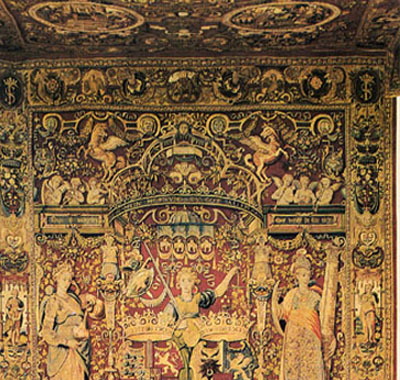
| | Frederik d. 2.s bordhimmel er et markant eksempel på den fyrstelige udsmykning. |
Et fyrsteligt slot som Kronborg krævede naturligvis kostbare udsmykninger af forskellig slags. Til at forestå dette blev der ansat internatinalt anerkendte kunstnere. Kronborgtapeterne, Frederik 2.s bordhimmel og Fontænen på slotspladsen blev pragtværker.
Kronborgtapeterne og Bordhimlen
Den store sal på det nyopførte Kronborg Slot blev udrustede med en suite tapeter/gobeliner, der forestillede (påståede) danske konger. Disse var komponerede af nederlænderen Hans Knieper. Han var oprindelig maler, men havde også en vis indsigt i tapetvæveriernes finesser og overvågede selv i Danmark arbejdets gang. Det drejede sig om en meget stor produktion, der talte 40 tapeter.
Fredrik 2. lod sin egen indsats forevige på den centrale gobelin i Hans Kniepers serie. Kungen selv er afbilledet i forgrunden sammen med sin søn(senere Christian 4.). Et par adelsmænd optræder i baggrunden. Man mener, at den ene af adelsmændene forestiller Tycho Brahe.Allerede i kontrakten med Knieper står der, at på den plads, hvor hans elskede Dronning skal stå "den daselbst sol ein Himmel mit dem Rückstück wie gebreuchlich auffgerichtett werden...". Kongetapeterne blev færdige i 1585 og samme efterår gik man i gang med kronen på værket, bordhimlen, som bærer årstallet 1586.
Bordhimlen blev udført med den allerstørste omhyggelighed og med rig anvendelse af guld- og silketråde udenom den dominerende silke. Den skiller sig afgørende ud fra kongetapeterne med disses grovere forarbejdning. I en nutidig svensk kunsthistorisk artikel kan man læse at den ”I sin velbevarede tilstand er et af hovedværkerne blandt de kunstskatte der befinder sig i Sverige". Grunden til at bordhimlen er så velbevaret er at den i mange år lå nedpakket, da man på grund at den udprægede danske heraldik ikke ville anvende den på noget kongeligt slot i Sverige.

Frederik 2. |
Analyse af Bordhimlen
Som helhed hænger himlens komposition sammen med de vævede tapeter, hvor det samlede udtryk præges af grotesker, en genre som blev mode ved femtenhundrede tallets midte. Kompositionen går hovedsaligt tilbage til Cornelis Floris, men i den kraftige tegning ser man også indflydelse fra Vredeman de Vries.
Rygstykket viser Frederik 2. og og hans hustru Sophie af Mecklenburgs våbenskjold. Bag våbenskjoldet står en kvindefigur, Justia, retfærdighedens gudinde, med vægtskål og sværd. På siderne står: Temperantia, mådeligheden, der blander vand i vinen og Fortitudo, styrken, med sin attribut kolonnen.
Kongeparrets våbenskjold og figurerne er indsat i en rigt udformet groteskkomposition. Over våbenskjoldene er der indsat en luftig gennembrudt baldakin, på hver side er der en slags bjælker med muciserende "putti". De tre store kvindefigurer står på et smalt postament. Nedenfor dette optræder to flodguder og diverse dyr.
Himlen har i midten det danske rigsvåben, omkranset af to putti, som flyver opad. Våbenet er omkranset af en slags "beslagværk" med fire runde medaljoner, der alle indeholder kongelige dyder. De områder af Himlen, der ikke er udfyldt af rigsvåbenet og medaljonerne er fyldt ud med groteskstilens typiske elementer: fantasidyr, figurer og blomster. I borden gentages groteskornamenterne og mellem dem, er der indsat heraldiske emblemer. Som en svenske kunsthistoriker understreger: "det hela är ett magnifikt uttryck for groteskstilen i dess nederländska form och rull- och beslagsverk".

Frederik 2.s bordhimmel | 
Bordhimmel | 
Bordhimmelen |
Fontænen på Kronborg
Allerede i begyndelsen af Kronborgbyggeriet (1576) bestilte Frederik.2, sandsynligvis på anbefaling af Tycho Brahe, en "vandkunst" hos den berømte bronzestøber G. Labenwolf i Nürnberg til Kronborgs store gårdsplads. I sin helhed er der tematisk tale om Hav og havdyr. En letfattelig allegori med Neptun (Frederik.2) på toppen af fontænen som havenes (Øresunds) behersker med den strømmende rigdom (Øresundstolden).
Der skulle dog gå syv år fra bestillingen til mesterværket under stor festivitas kunne indvies. Den lange leveringstid passede bestemt ikke Frederik.2, og de skriftlige kilder beretter om mange genvordigheder. Bl.a. blev figurfremstilleren truet af byrådet i Nürnberg med fængselsstraf, hvis han ikke opfyldte sine forpligtelser som "underleverandør". Årsagen til billedhuggerens problemer med dette antydes med at magistraten i Nürnberg i 1582 formente ham adgang til "alle kældre og værtshuse", mens færdiggørelsen fandt sted. Det hjalp. Fontænen blev leveret i 1583.

Fontænen | 
Fontænen i slotsgården |
Fontænens skæbne
Man kan desværre ikke se fontænen på Kronborgs slotsplads i dag. Under svenskekrigene i 1600-tallet blev fontænerne på både Kronborg og Frederiksborg Slot demonteret og ført til Stockholm som krigsbytte.
For Kronborgfontænens vedkommende troede man i mange år, at hele fontænen var støbt om, bl.a. til kirkeklokker, men nyere forskning har sandsynliggjort, at de tre gudindefigurer, på mirakuløs vis, har overlevet, og at de siden 1917 har kunnet beses på det svenske Nationalmuseum. Beviset for at det er de rigtige figurer skyldtes bl.a. at man fandt huller i figurernes brystvorter, hvorfra vandet i sin tid lystigt sprang og huller i bunden, hvortil vandet blev ledt ind.Borgerhuse
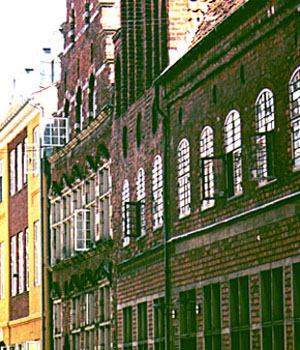
| | Både Helsingør og Malmø kan opvise eksempler på fornemme borgerhuse fra slutningen af 1500- og begyndelsen af 1600-tallet.
Helsingør blomstrer og udvides betydeligt. Her ses husrækken Stengade 70-76, i Helsingør, hvor et sengotisk stenhus, det nuværende dommerkontor, afløses af et gavlhus med typiske stiltræk fra renæssancen. |
Renæssancehuse
Opførelsen af Kronborg bygger på et praktisk samvirke imellem kongemagten og byen og de mange håndværkere, der blev indforskrevet og boede rundt omkring i byen. Aktiviteten ved byggeriet og den stigende handel og omsætning i forbindelse med Øresundstolden medfører at indbyggertallet vokser, med et udtalt islæt af fremmede indvandrere, tyskere, hollændere, briter m.v., og det sætter sig også spor i byggeriet rundt omkring i byen. Mindst et par huse har således direkte tilknytning til byggeriet på Kronborg.
Det gælder f.eks. tolder David Hansens gavlhus, Stengade 76 opført i 1579. Fundamentet er af ældre dato, den kamtakkede gavl har endnu gotikkens præg, men de vandrette sandstenbånd, sandstensindfattede vinduer og skulpturudsmykkede gavlfelter er umiskendeligt renæssancens og facaden som helhed minder om Kronborg. Ejeren findes afbildet på et epitafium, en mindetavle, i Helsingørs Sct. Olai kirke.
I perioden kommer også en helt ny gade til, Strandgade, og man finder i Jacob Willumsen Badskærs gård fra 1592 et eksempel på rendyrket renæssancebyggeri af usædvanlig egenart med udsmykkede sandstens- pilastre. Malmø, næst efter Helsingør den største provinsby i området, er også præget af stigende handel og borgerskabet indflydelse og også her afspejler det sig i prestigefyldte renæssancehuse i sten.
Jørgen Kock opførte omkring 1525 et stenhus i Malmø som fremstår som et tidligt eksempel på den velhavende borgerstands formåen. Huset har endnu gotikkens kamtakkede gavle, men de vandrette sandstensbånd og dekorationerne på gavlfladen varsler renæssancestilens indtog.

Stengade 70 - 76 | 
Tolder David Hansens hus, Helsingør | 
Tolder David Hansens epitafium | 
Strandgade, Helsingør | 
Borgerhus, Malmø |

Jørgen Kocks hus Malmø |
Bindingsværkshuse
Udover stenhusene er der i Helsingør adskillige bindingsværkshuse med renæssancens præg. Et smukt eksempel på dette er borgmester Iver Pedersens gård på hjørnet af Stengade og Skyttenstræde, opført omkring 1600 med rigt dekorerede bindingsværk.
Bindingsværkshuse i renæssancens stilart findes vidt udbredt rundt omkring i Øresunds- regionens byer f.eks. også i Ystad, hvis atmosfære endnu i dag minder om Helsingør.

Bindingsværkshus, Helsingør | 
Bindingsværkshus, Ystad | 
Bindningsværkshus Helsingør |
Tycho Brahe
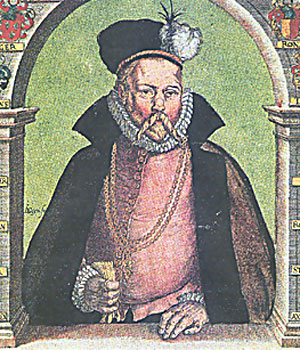
| | På øen Hven midt i Øresund levede og virkede Tycho Brahe fra 1576-1597, i alt 21 år, hvor han udover de astronomiske observationer også dagligt foretog meteorologiske optegnelser, dyrkede kemien (alkymi), havekunst, lavede instrumenter, tegnede kort, digtede og meget mere.
Med sine alsidige interesser og beskæftigelser er Tycho Brahe et nordisk eksempel på renæssancens universalgeni. |
Tycho Brahe - opvækst og uddannelse
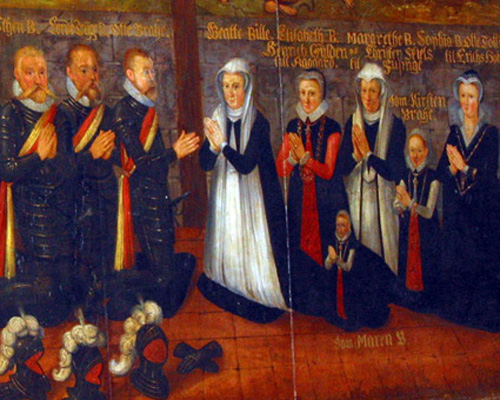
| | Tycho Brahe blev født d.14.december 1546 på godset Knutstorp i Skåne, men blev bogstavelig talt bortført og opdraget hos sin barnløse onkel Jørgen Brahe på Tosterup i det sydøstlige Skåne.
En sådan praksis var ikke usædvanlig i adelige kredse, hvor det ikke var kerne-familien, men slægten der spillede den store rolle. |
Tycho Brahe - adelsmand og renæssancemenneske
Da en fransk gesandt, Charles Ogier, i året 1634 efter et besøg i Helsingør forlader byen kører han sydover mod København og har udsyn til øen Hven, hvilket får ham til at tænke på den verdensberømte astronom Tycho Brahe.
Det er mere end tvivlsomt om man fra Sjællands kyst kan fornemme Hvens tilnærmelsesvise kvadratiske form, men det er ikke tilfældigt, at Ogier hæfter sig herved. Det symmetriske, velordnede og sammenhængende appellerer til renæssancemennesket og et sådant er også videnskabsmanden Tycho Brahe, i dansk sammenhæng nok det bedste eksempel på et universalgeni i renæssancens ånd.

Tycho Brahes Hven |
Barndommen
Tycho Brahe var født højadelig, og som sådan forventedes det at han siden hen gjorde karriere som godsejer, kriger og eventuelt rigsrådsmedlem, som så mange af hans slægtninge. Ikke desto mindre havde han et noget tvetydigt forhold til sine standsfæller.
Tycho Brahe blev født d.14.december 1546 på godset Knutstorp i Skåne, men blev bogstavelig talt bortført og opdraget hos sin barnløse onkel Jørgen Brahe på Tosterup i det sydøstlige Skåne. En sådan praksis var ikke usædvanlig i adelige kredse, hvor ikke kerne-familien, men slægten spillede den store rolle. Familien Brahe ses afbildet i 1613, altså efter Tyges død, i Kågerød kirke, der var patronatskirke til Knutstorp.
Der er her tale om en mindetavle, et epitafium anbragt på den nederste del af en slags altertavle i kirken. I midten ses forældrene Otto Brahe og Beate Bille. Ved siden af faderen Tyge (den lærde) og udefter brødrene Steen, Axel, Jørgen og Knud. Ved siden af moderen søstrene Lisbeth, Margrete, Kirstine og endelig Sophie Brahe, der stod Tycho Brahe meget nær.

Tycho Brahe | 
Knutstorp | 
Tosterup | 
Brahefamiljens epitafium |
Uddannelsen
I en alder af 6 år startede Tycho Brahe i skole, hvilket ikke var ualmindeligt for standen. Usædvanlige er imidlertid de interesser, som han siden hen under sin uddannelse kaster sig over. Som tolvårig starter han på universitetet i København, der i denne periode er åben overfor og præget af tidens renæssancehumanistiske tankegang.
Vi ved fra kendskab til Tycho Brahes bogsamling, at han allerede i denne periode fatter interesse for astronomien, og under hans studierejser i begyndelsen af 1560erne er det i ly af jurastudierne denne videnskab han begynder at praktisere. Med sig på rejsen havde Tyge den borgerlige Anders Sørensen Vedel, der også er en vigtig renæssanceskikkelse. Bl.a. samler han som den første gamle danske folkeviser til en udgivelse.

Anders Sørensen Vedel |
Astronomi
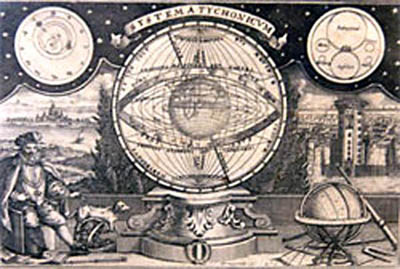
| | I 1572 observerer Tycho Brahe under et ophold hos sin morbroder Steen Bille på Herrevadskloster en ny stjerne i stjernebilledet Cassiopeia. Nu ved vi at der var tale om en såkaldt super nova, en hendøende stjerne.
Beskrivelsen af denne opdagelse bliver starten på Tycho Brahes berømmelse. Med tiden når Tycho Brahe også frem til et samlet verdensbillede, der dog ikke stemmer overens med Copernicus´. |
Nova Stella og det nye verdensbillede
Tycho Brahe studerer i udlandet og først i slutningen af 1570 vender han tilbage til Danmark og opholder sig tilsyneladende mest på Herrevad Kloster hos sin morbroder Steen Bille, der interesserede sig levende for kemiske og mekaniske eksperimenter.
Under et besøg der i november 1572 observerer Tycho Brahe, hvad han antager for at være en ny stjerne i stjernebilledet Cassiopeia og stærk tilskyndet, men noget imod sin vilje udgiver han en bog, "De Nova Stella", om den ny stjerne. Det var kontroversielt for en adelsmand at beskæftige sig med sådanne sager og den indledes da også med en række indlæg, der opregner argumenter for og imod en udgivelse.
Bogen, der trykkes i få eksemplarer i København, indeholder i manuskriptform tillige med afhandlingen om den nye stjerne en astrologisk og meteorologisk almanak for året 1573, samt en afhandling om en kommende måneformørkelse og afslutningsvis et digt til himmelguden Urania, alt sammen på latin. Umiddelbart kan det forekomme at være et besynderligt sammensurium af et skrift, men for Tycho Brahe er der indbyrdes forbindelser imellem disse beskæftigelser.

Nova Stella | 
Tycho Brahes verdensbillede | 
Verdensbillede |
Empirikeren Brahe
Måske er Tycho Brahe for beskeden med hensyn til rækkevidden af sine iagttagelser. Værkets astronomiske hovedærinde bliver gennem nøjagtige observationer at påvise mangler i den herskende opfattelse af det astronomiske verdensbillede. Ifølge dette er universet skabt på engang og der sker ikke ændringer uden Vorherres direkte indgriben.
Tycho Brahe vil ikke give sig af med at gisne om den bagvedliggende årsagssammenhæng, men bidrager her som i senere værker til en mere dynamisk opfattelse af det astronomiske verdensbillede. Tycho Brahes store fortjeneste livet igennem ligger i hans nøjagtige empiriske observationer og optegnelser, men bag dette også en erkendelse af at universet var uendeligt meget større end man antog og under stadig udvikling. I denne forstand var Tycho Brahe den første moderne astronom, men han vælger dog at imødegå Kopernikus nye verdensbillede, hvor solen og ikke jorden var universets centrum.

Tycho Brahes verdensbillede | 
Obeservationsscene | 
Sekstant | 
Himmelglobus |
Om Kometen
Da Tycho Brahe nogle år senere, på Hven i 1577, får lejlighed til at iagttage en komet udbygger han sine iagttagelser og konklusioner. I sit lille skrift "Om kometen", der er forfattet i 1578, men først udgivet med 350 års forsinkelse sammenfatter han sine iagttagelser over den ny stjerne og kometen.
Ligesom i værket om den ny stjerne anvendes også her en stor del af pladsen til astrologiske forudsigelser.
Astrologiens status
Tycho Brahe er imidlertid meget forsigtig i sin omgang med de astrologiske forudsigelser, hvilket han også præciserer i det efterfølgende:
"..skønt det er alle mennesker skjult at kende den rette grund til fremtidige ting, kan man dog fra de gamle erfarne astrologers observationer og lære få nogen anvisning på, hvad sådanne undere på himmelen kan udrette, hvilket lader sig gøre uden nogen som helst overtro(side 37-38)".
Når Tycho Brahe tager disse forbehold og må understrege sin afstandtagen til overtroen hænger det sammen med at astrologiens status også i samtiden var meget omdiskuteret, både blandt renæssancens tænkere og kirkens folk. Dog havde den en vis officiel status, som når f.eks. Tycho Brahe som en del af sine forpligtigelser overfor kongemagten lægger kronprinsens horoskop.
De astrologiske forudsigelser i samtiden deles op i to hovedgrupper: De meteorologiske og astrologiske. Udgangspunktet er nogle grundlæggende iagttagelser omkring planeternes indvirkning på livsbetingelserne, f.eks. det at solen afgiver varme og lys, at månen har indflydelse på tidevand, skiften imellem sommer og vinter osv. Den eksakte viden om disse forhold var naturligvis begrænset, men netop derfor kunne man jo også gøre sig forestillinger om disse forholds rækkevidde.

Christian IV´s horoskop |
Skaberens rolle
Som påpeget er Tycho Brahe meget forsigtig og forbeholden overfor astrologien og bliver det måske i stigende grad. Dog bliver han på intet tidspunkt fornægtende og det hænger sammen med at astrologien for ham indgår i en karakteristisk helhedstænkning.
I det hele taget er det interessante selve forholdet imellem de astronomiske og astrologiske overvejelser og universets skaber, altså Gud. Vorherre fremstår her som andre steder i skriftet som en bagvedliggende kraft, en almægtig igangsætter, hvis tilstedeværelse kan iagttages i naturens orden. Vorherre griber ikke straffende ind i begivenhedernes gang, men holder sig til de afgørende beslutninger omkring skaberværket og mennesket kan ikke tolke hans vilje i naturfænomenerne. I sin opfattelse af gudsbegrebet nærmer Tycho Brahe sig her en senere tids opfattelse.
Voksende anerkendelse
Tycho Brahes observationer vinder løbende anerkendelse og fra 1574 holder han, usædvanligt for sin stand, forelæsninger på universitetet. Senere får han tilbudt stillingen som rektor for universitetet, hvilket han takker nej til. Tilbuddet vidner dog om den bevågenhed han nyder, også hos kongemagten, og som bliver afgørende for hans udvikling i årene fremover.Uranienborg
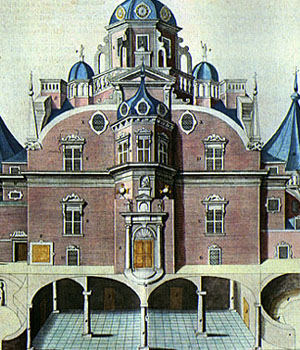
| | Renæssanceslottet Uranienborg var Tycho Brahes bolig og forskningscenter. Fra balkonerne i bygningens øvre etager kunne man observere stjernehimmelen. I kælderen til venstre oprettedes et kemisk laboratorium.
Tæt ved Uranienborg fik Tycho Brahe opført Stjerneborg for bl.a. at sikre et mere stabilt underlag for sine følsomme instrumenter. |
Uranienborg på Hven
Renæssancefyrsten Frederik 2.havde blik for Tycho Brahes format og tilbød ham støtte og d.18.2.1576 tilstedes han en årlig udbetaling på 500 daler, en statsstøtte af dimensioner. Kongen havde under tilsyn med byggearbejdet på Kronborg fået øen Hven i tankerne, som et passende sted for Tycho Brahes virksomhed, og Tycho Brahe kunne få den som len på fordelagtige vilkår, hvis det kunne afholde ham fra at rejse til udlandet. Tycho Brahe accepterer kongens tilbud.
Ovenikøbet får Tyge 400 rigsdaler til opførelse af et hus på Hven. I august 1576 påbegyndes byggeriet af Tycho Brahes nye bolig Uranienborg, opkaldt efter himmelgudinden Urania. Det praktiske arbejde udføres som hoveriarbejde af øens bønder, og som ledere af byggeriet har man bl.a. foreslået to af de fra Kronborgbyggeriet kendte nederlandske bygherrer Hans von Paeshen og Hans van Stenwinckel. Selve byggeriet er inspireret af norditaliensk renæssance, som Tycho Brahe har stiftet bekendtskab med under sine udenlandsrejser, og der er næppe tvivl om, at han selv har bidraget til udformningen af byggeriet.
I vore dage er der ikke mere tilbage af slottet.
En symbolsk bygning
De centrale del af grundplanen udgøres af et kvadrat, der måler 60 fod, ca 15,5 meter på hver side. Dette kvadrat deles af vinkelrette korridorer, der deler grundkvadratet i fire ens mindre rum og endvidere forbinder symmetriske tilbygninger i nord- sydlig retning og ligeledes symmetriske indgangspartier i øst og vest.
Bygningen består af to etager, fuld kælder og en kvistetage. Uden påbygningen er tilføjet altaner til brug for observationer og en del af kælderen er beregnet til kemisk laboratorium. Astronomien og kemien/medicinen var de videnskaber man ville give sig af med og det angives tillige med to figurnicher over indgangspartierne. De allegoriske fremstillinger her har været knyttet sammen med nogle korte latinske inskriptioner: DESPICIENDO SUSPICIO og SVSPICIENDO DESPICIO, hvilket betyder noget i retning af: Idet jeg ser ned skuer jeg opad, og idet jeg ser op, skuer jeg nedad.Den første sentens er møntet på de kemiske eksperimenter, den anden refererer naturligvis til de astronomiske studier.

Uranienborg | 
Grundplanstegning |
Stjerneborg
Det var vigtigt at instrumenterne stod helt stille, hvilket viste sig at være svært i en bygning. Derfor fik Tycho Brahe bygget Stjerneborg, hvor instrumenterne blev placeret på marken eller under marken. Dermed blev underlaget så stabilt, at fejlmålinger på det nærmeste forsvandt.

Stjerneborg | 
Stjerneborgs anlæg | 
Stjerneborgs anlæg |
Kosmologien
Den dybere mening med Tycho Brahes valgsprog er, at de videnskabelige studier har kosmologisk sammenhæng, at der er indbyrdes forbindelse imellem studiet af de jordnære ting og det guddommelige og at studiet af planetsystemets opbygning har relation til den jordiske tilværelse.
Uranienborg var således ikke alene hjem og arbejdssted for Tycho Brahe, men udtrykte tillige arkitektonisk og på anden vis den livsopfattelse og verdensanskuelse, der ligger til grund for Tycho Brahe og mange andre renæssancehumanisters arbejde og virke: En tro på at udforskning og kortlægning af virkeligheden vidner om den kosmologiske sammenhæng, der ligger bag.
Havekunst og medicin
Det samlede kompleks omkring Uranienborg viser igen det sammenhængende og symmetriske, her i haveanlægget og de omgivende voldanlæg. Haveanlægget er et af renæssancens interesseområder, men her har det også tjent mere praktiske formål, idet træerne også var frugttræer og bedene rummede såvel grøntsager, som urter, der også kunne indgå i medicinske opskrifter.
Vi ved at både Tyge og hans lærde søster Sophie Brahe, der i lange perioder opholdt sig på Hven, gav sig af med at fremstille medicinske præparater, endda i et sådant omfang, at apotekerne i København klagede over det. Det er sandsynligt, at Sophie Brahe har deltaget i anlæggelse og pleje af haveanlægget, men sikre beviser for det har vi ikke.

Have- og voldanlæg | 
Grundplan |
Tycho Brahe forlader Hven
Tycho Brahe bliver på Hven i 21 år, frem til 1597, hvor han falder i unåde og nødtvungent forlader Danmark og i 1599 slår sig ned i Prag, hvor han dør i 1601. Omstændighederne omkring Tycho Brahes fald er fortsat uklare og omdiskuterede. Fra Rostock skriver Tycho Brahe i 1597 selv til kongen, at han ikke er draget i eksil og forsikrer om sin fortsatte loyalitet. Kongen bebrejder ham, at han er drager bort uden tilladelse ogpå peger uoverensstemmelser, idet han henviser til "Klagemaal vore fattige Undersaatter og Bønder paa Hven imod dig haver haft" og hans forsømmelighed mod kirken sammesteds, herunder "Udi hvad Maade Daabsens Ord ere udi langsommelig Tid udeladte, imod disse Rigers vedtagne Brug, med dit Vidskab, sligt er hver Mand altfor vitterligt."
At Tycho Brahe ikke overholdt sine lensforpligtigelser til punkt og prikke er en kendsgerning, han forsømte at passe fyret på Kullen og værre endnu det kongelige gravkapel i Roskilde Domkirke. Det kan imidlertid undre at stridsmålet med bønderne drages frem i en tid, hvor det er enhver herremands ret at udnytte sine undergivne og hvor byrden på bønderne generelt set øges betydeligt.
Djævleuddrivelsen
Hvis det er korrekt, at man på Hven i Tycho Brahes tid havde forsømt, eller bevidst udeladt dele af dåbsritualet, kunne det, set med tidens øjne, være en alvorlig sag. Dåbsritualet og herunder især djævlebesværgelsen var i tiden et afgørende teologisk stridspunkt. Djævleuddrivelsen, var en gammel skik, som Luther videreførte fra katolsk tid, men som reformatoren Calvin udelod som utidssvarende. Tilsyneladende har andre delt denne anskuelse, heriblandt den humanistisk orienterede professor i teologi ved Københavns Universitet Niels Hemmingsen, i mange år universitetets ledende skikkelse, indtil han bliver afsat i 1579, som følge af en strid om nadverlæren, hvor han erkendte at have nærmet sig Calvins opfattelse af denne.
Striden om djævlebesværgelsen bryder for alvor ud da præsten Iver Bertelsen på Møn udelader besværgelsen og omkring 1567 stævnes herfor. Iver Bertelsen må tilbringe 3 år i fangenskab førend han tages til nåde igen af Frederik 2.I 1588, under Christian 4.s formynderskabsregering, kommer endnu en sag, da præsten ved Helligåndskirken i København, Jon Jacob Venusin, ved en dåbshandling åbenlyst udelader djævlebesværgelsen.
Venusin, der stammede fra Hven, hvor hans far havde været præst, var berejst og besvogret med Tycho Brahes svigersøn. Hvis han har troet, at formynderregeringen under den mindreårige Christian 4. var ham venligt stemt tog han imidlertid fejl. 3 uger efter hans gerning udsteder man i kongens navn et forbud imod "at opvække unødige disputatser", med trussel om straf til følge.
Indirekte anklager
Det er omkring samme tidspunkt at kongens udfald mod Tycho Brahe tager sin begyndelse, i første omgang rettet imod præsten på Hven, der anklages for ikke at straffe og påminde Tycho Brahe om hans manglende altergang og utugtige levned, idet der hermed hentydes til Tycho Brahes ugifte samliv med en uadelig, hvad der dog strengt taget ikke var ulovligt. Sidst men ikke mindst anklages præsten for på Tycho Brahes foranledning at have udeladt djævleuddrivelsen af dåbsritualet. Præsten mister sit embede herfor og i næste omgang rettes skytset så imod Tycho Brahe selv.
En anden uofficiel anklage imod Tycho Brahe gik på at han fremstillede medicin uden tilladelse fra kirken, som skulle godkende sådant. Skønt han var yderst varsom i sin omgang med astrologien, har han indsats på dette område sikkert også bedraget til billedet af en suspekt person med store og måske overnaturlige evner, en troldmand.
Eksklusiv syndebuk
Tycho Brahe kan med andre ord mistænkes for calvinistiske og kætterske tilbøjeligheder, og man indser at Tycho Brahe er en torn i øjet på den efterhånden herskende snæversynede, religiøse ortodoksi. Hans renæssancehumanistiske syn og levemåde stødte dele af de herskende kredse, og meget tyder da også på at der er tale om en sammensværgelse imod ham. Et langt stykke hen ad vejen er han blevet et eksklusivt offer for den officielle moral.
Paradoksalt nok ender det i 1606 med at kongen under indflydelse af den tidligere omtalte Venusin angriber djævlebesværgelsen ved dåben og lader sin datter prinsesse Elisabeth døbe uden djævleuddrivelse. For god ordens skyld skal det nævnes at kong Christian året efter igen skifter standpunkt.
Tycho Brahes korrespondance med kongen offentliggøres først efter dennes død i 1648, men i 1597 skriver Tyge et digt om sit brud med Danmark, som indeholder følgende passage:
"Danmark, hvad har jeg gjort dig, at bort så grumt du mig støder?
Hvor kan, o fædreland! du mig behandle som fjende?
Løftet har jeg jo dit navn, det nævnes med hæder så vide,
siig, kan du vredes fordi, min virken har kranset med ros dig?
siig, hvem af dine børn har givet dig mer vel i eje!
Kan du vel vredes derofr, at højt på den hvælvede bue,
Fædreland! dit navn jeg skrev i de blinkende stjerner!
Hvorfor nu støde mig bort? Engang vil du sikkert mig mindes:
Kommende dage mit værd, min virken skal virkelig fatte,
børn af en senere slægt, på hvad jeg gav dig at bygge."Sophie Brahe
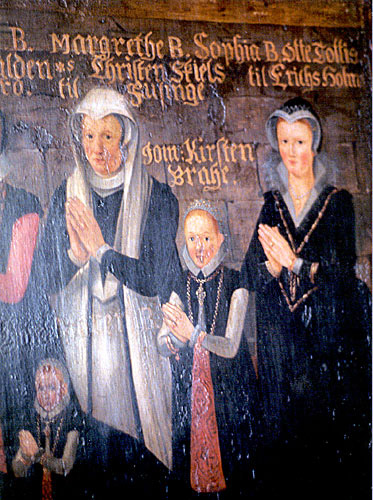
| | Sophie Brahe var som sin bror alsidigt begavet og interesseret som et typisk renæssancemenneske.
Kendt for eftertiden er hendes studier i danske adelsslægter, men hun interesserede sig også levende for lægekunst, fremstillede selv medicinske præperater og sendte i 1625 recept på en pesteleksir til kongen.
Endvidere dyrkede hun både astrologi og astronomi og havekunst. |
En renæssancekvinde
Da Charles Ogier i 1634 forlader Helsingør beretter han også, at han på vejen møder Tycho Brahes søster Sophie, som på det tidspunkt er sidst i 70erne. Hun havde altså da overlevet sin berømte bror med over 30 år, og havde ifølge det ældste kendte vidnesbyrd boet i Helsingør siden 1626.
Sophie Brahe var, som sin bror, alsidigt begavet og interesseret som et typisk renæssancemenneske. Kendt for eftertiden er hendes studier i danske adelsslægter, men hun interesserede sig også levende for lægekunst, fremstillede selv medicinske præperater og sendte i 1625 recept på en pesteleksir til kongen. Endvidere dyrkede hun både astrologi og astronomi og havekunst.

Brahe familien | 
Sophie Brahe | 
Mindetavle |
Sophie Brahes havekunst
Desværre kender vi intet nærmere til Sophie Brahes havekunst, som broderen berømmer. Hun har formodentlig hjulpet sin broder med haven på Hven, men også dyrket sin egen have på godset Eriksholm i Skåne og siden hen i Helsingør, hvor hun ejede en byejendom med tilliggender i udkanten af byen og tæt ved Kronborg.
Et brev til den svenske adelsmand Johan Sparre fra d.14. september 1629 vidner dog om hendes kundskaber. Første del af brevet handler om slægtsforskning, hvor Sophie har lånt og korrigeret nogle slægtstavler. Herefter skriver Sophie Brahe om blomsterløg og giver en anvisning på, hvordan de skal behandles.

Kejserkrone | 
Renæssancehave | 
Haveudsnit |
Renæssancehavens ide.
Uranienborgs haveanlæg var, som det fremgår af samtidige stik, et kvadratisk anlæg præget af symmetri ned i mindste detaljer. Det yderste bælte bestod af, sandsynligvis, frugttræer, som omgiver den indre del med de geometrsik udformede bede, som har rummet både nytte- og prydplanter. Overgangen imellem de to dele er markeret med fire ens lysthuse.
Uranienborgs have er speciel med den gennemførte symmetri, som formodentlig refererer til det samlede anlæg karakter af videnskabs- og forskningscenter. I denne forstand lever haven fuldt ud op til renæssancehavens ide: Den skal adsprede, men også udfordre og stimulere den besøgendes nysgerrighed og anspore til intellektuel og åndelig fordybelse. Det behagelige kombineres med det nyttige, - hvilket havens beplantning også vidner om.

Florens 1545 | 
Nortons botaniske værk 1597 | 
Kvan 1597 | 
Lavendel 1597 | 
Tulipan 1561 |
Eksterne links til 1500-tallet

| | Linkikonet åbner for hjemmesider, hvor der kan findes yderligere oplysninger om 1500-tallet. En del af disse tilbyder også en engelsk version eller resumé. |
|